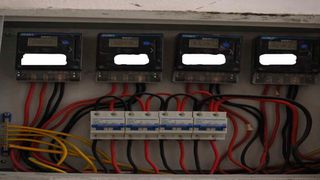
Electricity meters at an apartment block.
| File | Nation Media GroupNews
Premium
Your electricity bill is set to rise again this month – this is where it will go
What you need to know:
- On Friday, the Energy and Petroleum Regulatory Authority (Epra) increased the fuel cost charge from Sh3.77 last month to Sh3.88.
- The higher cost of power is set to further burden households when the prices of key commodities have risen sharply over recent months.
Your electricity bill this month will be the highest in 38 months, following the latest monthly review of electricity prices by the government last week.
On Friday, the Energy and Petroleum Regulatory Authority (Epra) increased the fuel cost charge from Sh3.77 last month to Sh3.88, the highest it has reached since July 2018, and the foreign exchange fluctuation adjustment from 68 cents to 76 cents per unit.
“Pursuant to Clause 1 of Part III of the Schedule of Tariffs 2018, notice is given that all prices for electrical energy specified in Part II of the said schedule will be liable to a fuel energy cost charge of Sh3.88 Kenya per kWh for all meter readings to be taken in September, 2021,” Epra said on Friday.
The higher cost of power is set to further burden households when the prices of key commodities such as cooking gas, cooking oil, fuel and food have risen sharply over recent months on new taxation measures and shortages of crucial imports in the global market.
But with the new electricity prices, just what makes your electricity bill, and where is all the money going?
To start, your final electricity bill incorporates multiple charges and taxes that go to different companies and government agencies involved in the generation, supply and distribution of electricity, and regulation of the electricity sector.
Consumption charge
This is the single largest component of your power cost, and is billed per unit of electricity you consume over the month.
The proceeds from this charge are used to pay dozens of independent power producers for electricity generated and supplied to the sole distributor Kenya Power, through power purchase agreements.
For instance, if your household electricity usage this month is 200 units, your total power bill will be Sh3,835, and the consumption charge will total Sh2,037.
Fuel Cost Charge
While most of the electricity consumed in the country is hydro-generated (32 per cent) and geothermal produced (47 per cent), a significant number (7 per cent) is still generated by use of diesel to turn turbines.
But the price of diesel is volatile and is also reviewed monthly by Epra, which requires a consequent adjustment of the fuel cost charge each month to enable the expensive thermal electricity producers to recoup their costs.
Despite these producers being only the fourth largest electricity producers, their diesel costs alone make the second largest contribution to your power bill after the consumption charge, and will stand at Sh776 this month if you use 200 units.
Foreign exchange fluctuation adjustment
The aforementioned power purchase agreements between Kenya Power and the IPPs are denominated in foreign currencies, which affects the cost incurred by the utility company in compensating them relative to the shilling’s performance.
This necessitates the forex fluctuation to be adjusted monthly, which also cushions the utility company’s expenditure on imports and its huge cost of repaying its mammoth debt.
Sticking with a monthly consumption of 200 units, the forex fluctuation adjustment will set you back Sh152 on your power bill for this month. Epra on Friday increased the charge to 76 cents from 68 cents last month following the weakening of the shilling against major world currencies.
Inflation adjustment
The ever rising costs along the electricity generation, supply, distribution and regulation means a higher cost of electricity, which is catered for by the inflation adjustment rate.
The Kenya National Bureau of Statistics (KNBS) which tracks the monthly inflation rate, shows inflation hit 6.57 per cent, the highest since February last year, which has seen a corresponding rise in the inflation adjustment rate on the power bill.
For the same amount of units, this adjustment amounts to Sh94.
Epra levy
The energy regulator, which periodically sets electricity prices, also takes a cut from your power bill to cover its operational costs.
It makes one of the lowest costs on your power bill, and will be Sh6 for 200 units this month.
Rural Electrification Programme (REP) levy
Beginning in 1973, the government started the Rural Electrification Scheme to connect more rural households to the power grid.
The programme has since seen the number of households connected to electricity increase from about 400,000 to 7.5 million, with new electricity lines, substations and transformers helping the expansion drive.
Proceeds from the REP levy, making up 5 per cent of the power bill, go to the Rural Electrification and Renewable Energy Corporation (REREC) which is charged with connecting more rural households to the national electricity grid.
Value Added Tax (VAT)
Growing VAT collections is a critical cog in the Kenya Revenue Authority’s (KRA) plan to increase tax revenue to satiate the government’s growing spending appetite.
Taxing electricity is crucial in hitting these targets, with consumers charged a 16 per cent VAT on their monthly power bill, which is passed on to the taxman.
Water Resource Management Authority (Warma) levy
Hydropower is the second largest electricity generator in the country, with electricity users charged a monthly fee that is remitted to Warma for protection of water resources.
The levy, reviewed monthly by Epra, was reduced last week to 1.6 cents per unit from 1.67 cents last month.





